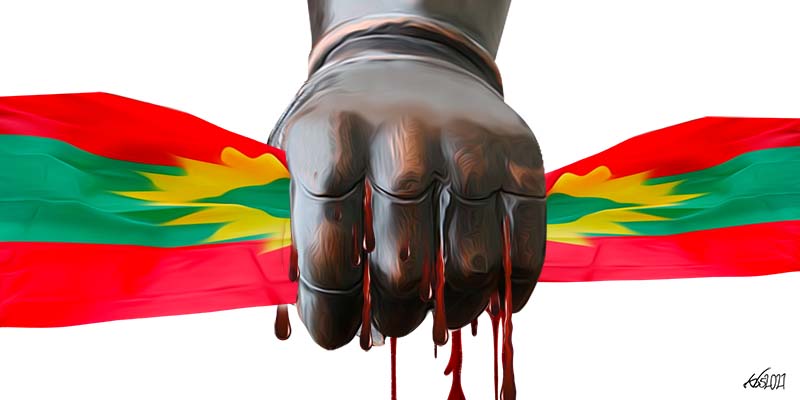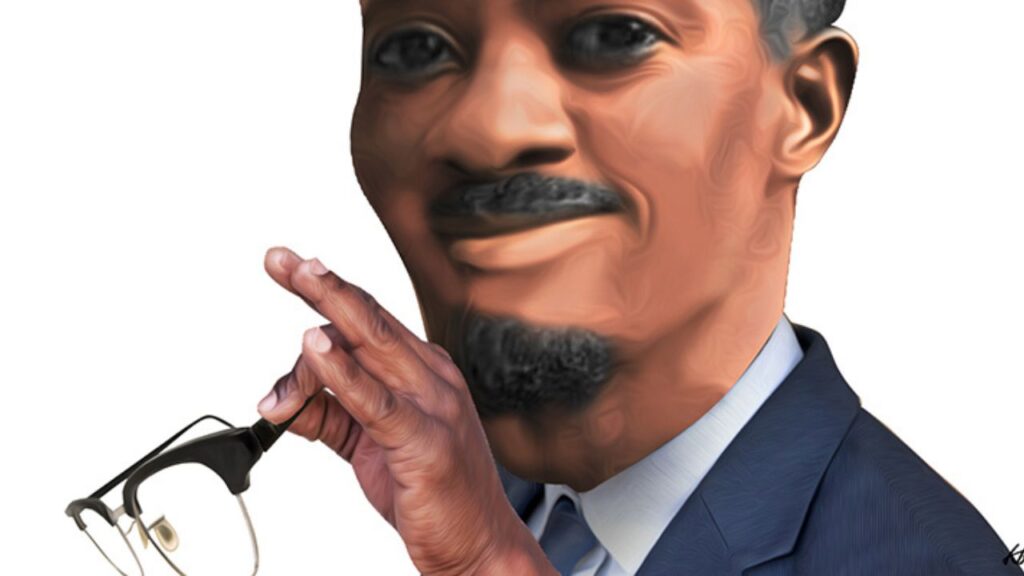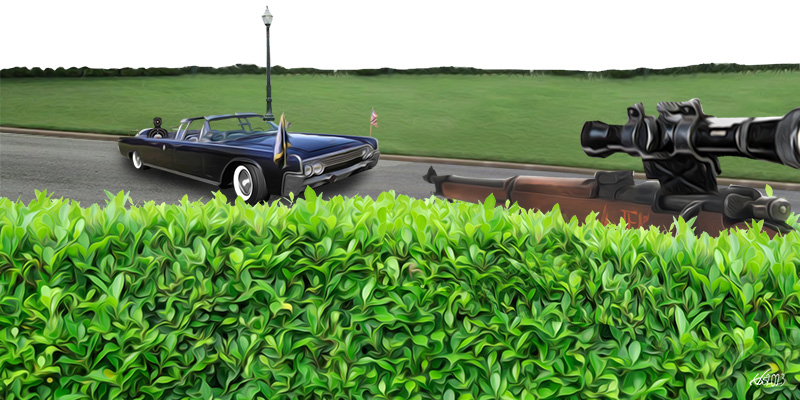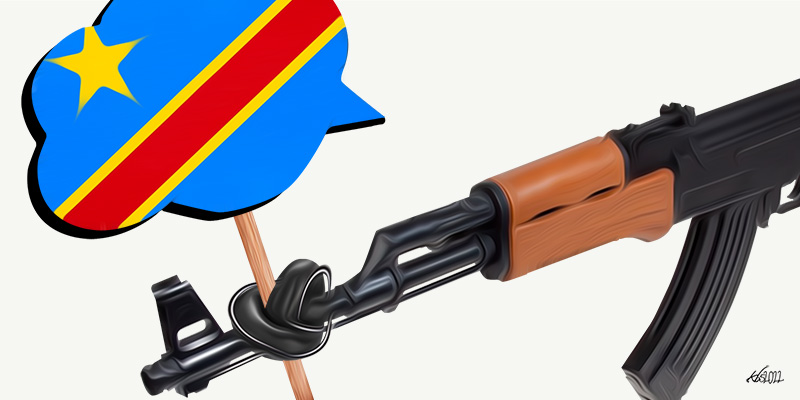On the evening of 1 December 2021, 14 respected, experienced and culturally venerated leaders of the Karrayyuu Oromo community of 100,000 in central Ethiopia were killed within minutes by Oromia Special Police and Federal forces operating on the orders of ruling party officials sitting a hundred kilometres away in Adama city.
The murdered men were located at Fantalle district, East Shewa Zone of the Oromia regional state in Ethiopia. They were killed execution-style at 7p.m. far from the village where they were abducted when Prosperity Party bosses gave the go-ahead signal via cell phone message to waiting members of the special forces. The murdered men had just finished conducting Waaqa Kadhaa, a sacred indigenous prayer ceremony held at a special site designated for that purpose. In the close-knit iconic livestock-rearing culture of the Karrayyuu people, this was an unthinkable atrocity.
We, a coalition of Oromo advocacy and human rights groups operating internationally consider that this horrifying series of events indicate the intentionality and destructiveness of Abiy Ahmed’s government against the Oromo and other southern and marginalized peoples who do not support his direction for the country. We urge the international community, in particular those concerned with justice, peace, stability and human rights, to take note of what has happened in Karrayyuu. Those who were deeply committed to spirituality and to democratic principles above all, were brutally massacred with lightning speed, an act that sends an ominous warning to the populace that no one is safe right now in Ethiopia.
Historic, political and economic contexts
The shocking massacre was carried out amid an ongoing brutal war between the Ethiopian National Defense Force (ENDF) and the Tigray Defence Forces in the north of the country, and with the Oromo Liberation Army in the south. The site of the killing is in the Karrayyuu camel-rearing, pastoral grazing and watering lands located close to coveted trade routes for lucrative commodities in a cash-strapped economy. This valued territory has become a target of territorial expansionism by Amhara militias emboldened by the failure of Abiy Ahmed’s government to protect vulnerable populations like the Karrayyuu.
In the days leading to the event, Karrayyuu Oromo community leaders had resisted allowing young people to leave their homeland to be conscripted into the ENDF in the north. Among Oromo communities throughout Ethiopia, the Karrayyuu are well known and esteemed for their consistent practice of the principles of the time-honoured Gadaa system of socio-political organization that encompassed all Oromo before their incorporation into Ethiopia at the turn of the 20th century.
These and other factors make the December tragedy resonate with the entire population and account for the sense of threat and foreboding among other vulnerable groups in the country.
The brutality against of the Karrayyuu Oromo, and their displacement, has historical precedent in Ethiopia. The Karrayyuu have been historically and repeatedly dispossessed of their pastoral land. They lost more than half of it when the government of Haile Selassie established a massive sugar cane plantation at Metahara and when the Awash National Park in the Awash valley was carved out of Karrayyuu territory 200 kilometres east of Finfinnee/Addis Ababa. Jobs at the sugar factory did not benefit the Karrayyuu but instead went to labour imported from other areas. Over the years, substantial contraband trade elsewhere in Ethiopia became extremely lucrative. The routes to the outlets for contraband goods in Djibouti and Somaliland – and therefore the flow of wealth and power – meet at Awash, just east of Fantalle, before running directly through Karrayyuu territory.
Karrayyuu land has been encroached upon by residents of the neighbouring Amhara Region for a number of reasons. They seek territorial expansion for farmland and control/influence over strategic trade routes, and have set their sights on the grazing lands of the Karrayyuu pastoralists. Since the regime of Abiy Ahmed came to power, Amhara Region militia have proceeded to encroach on adjacent Karrayyuu land, clearing vegetation and razing Oromo pastoral structures to the ground and moving signposts without any pushback from government forces who would be expected to enforce the law and protect established legal boundaries.
These aggressive moves by the militia are followed by the arrival of settlers who construct houses and begin farming. Before 2018, there were territorial disputes but “there was balance”, according to residents. Now a sign reading “Welcome to Amhara Region” has been erected 45 kilometres deep into Karrayyuu land, crossing the vital supply routes to Djibouti and Somaliland. The sign was dismantled eight times by Karrayyuu and nine times reconstructed by Amhara militia, until the Prosperity Party dispatched an armed pickup truck to support the Amhara in this struggle over the boundary marker by safeguarding the sign.
Local people interpret such actions as an indication that the Abiy Ahmed government is reviving the imperialistic and assimilationist policies of previous Ethiopian regimes. Actions such as these foment ethnic conflict and justify the use of violence in favour of one ethnic group over the rest of Ethiopia. Such policies invite greater instability in Ethiopia and in the region, as the wars in the north and the south attest. The Fantalle territory is currently a significant prize for Amhara expansionism at the expense of the Karrayyuu. The Abiy Ahmed regime is allowing and condoning this overt land grab.
The massacre and its aftermath
What is known about the Karrayyuu massacre is that Prosperity Party leaders sitting in Adama ordered the execution in cold blood of the Abbaa Gadaa and thirteen other individually selected Gadaa leaders in Fantalle district on the evening of 1 December.
Members of the Michile Gadaa, currently halfway through its eight-year term of office, were present in Motoma, the seat of the Gadaa, a sacred village within the loose collection of hamlets that comprise the area of Karra. They had met on the morning of 1 December 2021 for a prayer ceremony, Waaqa Kadhaa, and had returned to their huts when five vehicles arrived, several of which had mounted machine guns, carrying about 20 Ethiopian government “security forces” — described as a mixture of Oromia Special Forces, Federal soldiers and police.
Local people interpret such actions as an indication that the Abiy Ahmed government is reviving the imperialistic and assimilationist policies of previous Ethiopian regimes.
These “security forces” called out from their homes several dozen people who had attended the ceremony and read out the names of 40 individuals. All forty Gadaa leaders, including their overall leader, the Abbaa Gadaa, Kadiro Hawas Boru, and Gadaa Councillor, Jiloo Didoo, came forward and peacefully submitted after discussing among themselves about the consequences of complying.
Traditional weapons which were worn for the ceremony, and rifles owned by about 20 of the men were removed from their homes and piled before them. Once their weapons had been taken, they were subjected to verbal and, increasingly, to physical abuse.
When the men asked the government forces what they had done to deserve such treatment, the Abbaa Gadaa advised everyone to keep calm, saying there was nothing to fear because they had done no wrong. He informed the soldiers that Abiy Ahmed had visited the area twice and spoken with him personally. Kadiro showed the soldiers a gift he had been given by Abiy Ahmed to prove this claim. (It appeared to be a sort of key fob.)
The forty Gadaa leaders were taken to Anole, an isolated arid area about six kilometres from the village, where they were divided into two groups. Sixteen, including the Abbaa Gadaa, Kadiro Hawas Boru, and Jiloo Didoo remained in Anole where, according to two eyewitnesses who later escaped, they were forced to lie face down on the ground and beaten. The Abbaa Gadaa was separated from the group several times during the day and beaten within earshot of the others. There were many screams of pain but the witnesses were lying face down and unable to see what was happening most of the time.
Throughout the day, there were phone calls between the commander of the soldiers holding the detainees and Prosperity Party headquarters in Adama to discuss the fate of the detained. According to the two escaped leaders, members of the Oromia Special Forces spoke with government officials in Adama to receive instructions and orders to kill the Karrayyuu elders.
Finally, after dark, around 7p.m., the 16 men were lined up and their heads were covered before execution. When the firing started, one of the soldiers threw his gun down and shouted, “I cannot kill Oromo. I cannot kill Karrayyuu!” Hearing this, two of the 16 Gadaa leaders seized the opportunity to run off and escape. The fate of the reluctant soldier is not known. His body was has not been found, although the witnesses reported that he was sharply rebuked by his fellows as the witnesses escaped.
The Abbaa Gadaa advised everyone to keep calm, saying there was nothing to fear because they had done no wrong.
Villagers had heard prolonged shooting during the night and, tipped off by the eyewitnesses, located the killing field later in the morning of 2 December. A soldier guarding the corpses tried to prevent community leaders from taking the bodies but he was chased away. The 14 bullet-riddled remains of the Gadaa leaders were taken back to Karra for burial. Their bodies had already been attacked by wild animals when they were found.
The government’s initial response was to announce that the killings were carried out by “Shane” (Oromo Liberation Army, OLA), a claim that had no credence or evidentiary basis and has since been contradicted by senior officials of the Prosperity Party themselves who have claimed that the Oromia Regional Government is responsible.
Local informants believe that only a disagreement between members of the security forces on 1 December prevented all forty men from being executed in Anole.
The other 24 Gadaa leaders were driven 55 kilometres southwest to a military camp at Wolenchiti, where they were detained and tortured for six or seven days before being transferred to a secret location in Mojo, 28 kilometres on the other side of Adama, along the road to Finfinnee/Addis Ababa. The beatings and torture continued.
Local informants believe that only a disagreement between members of the security forces on 1 December prevented all forty men from being executed in Anole.
One of the detainees, Jiloo Boraya Hawas, who was in his fifties, died from his injuries on 8 December in Mojo. His body lay in the cell with the other detainees for 24 hours before being moved to a container next to the cell where it stayed until Karrayyuu elders tracked down the detainees and confronted their captors on 10 December. The body of Jiloo Boraya Hawas was taken back to Karra where he was buried on 11 December.
Other detainees received hospital treatment before being returned to detention. Six were released to return home on 31 December. The others remain in custody. The presence of these detainees in Mojo and the testimony of the two leaders who escaped the massacre and lived to share their eyewitness accounts, have prevented further claims that the killings were the work of OLA.
The implications for the Karrayyuu
The speed and ferocity of this attack on the sacred and revered Gadaa institution have shocked Oromo communities across the world. The Gadaa is more than a religious institution: it is the core of Oromo identity, the basis of law-making, morality and ethics, civil conduct, and the foundation of a democratic ethos shared by Oromo and other Cushitic peoples of Ethiopia.
Oromo democracy, which predates any western equivalent by several centuries, and includes more checks and balances, is grounded in the Gadaa. The Karrayyuu killings are of enormous significance to all Oromo – whether followers of Waaqefata (traditional monotheist Oromo religion), Christianity or Islam.
Although Prosperity Party officials have been known to spread false information in the past, it is worth noting that they have stepped forward to offer this information, which contradicts earlier government statements that falsely accused OLA “Shane” of the brutality. A leaked one-page letter containing reports of the Karrayyuu massacre written to the Oromia Police Commission and the Attorney from the Ethiopian Human Rights Commission also confirms, “The order to commit the killing was given from above.”
The persecution of Karrayyuu Oromo had intensified prior to the massacre. Those found in urban areas, buying goods or seeking medical attention, were liable to face beatings and imprisonment. Local estimates are of 200 persons detained, including women and the elderly. They cannot be reached by relatives bringing food and are kept incommunicado. Since the atrocity on 1 December, movement has been further curtailed. Karrayyuu pastoralists are prevented from taking their animals to essential water and pasture. They are now forbidden to carry arms that have been essential to their livelihood, protecting their camels. Now they are arrested or shot if seen carrying rifles.
When the firing started, one of the soldiers threw his gun down and shouted, “I cannot kill Oromo. I cannot kill Karrayyuu!”
Within a few weeks of the massacre, the sacred Gadaa village at Motoma was razed to the ground by Amhara Region Militia. The Karrayyuu who resisted are accused of supporting OLA.
We call for a thorough investigation of the Karrayyuu massacre that will identify the perpetrators, and confirm who ordered and who performed the executions, so that the entire chain of command can be held accountable. Such a disclosure will reveal the nature of the regime in power and provide insight into the mechanisms by which impunity prevails in Oromia.
We call for the Karrayyuu community’s territories to be respected. Amhara militia should be instructed to evacuate the areas immediately. Federal military forces need to return to their barracks. Traditional and ceremonial arms should be returned so that the Karrayyuu may restore their lives and livelihoods. Confiscated camels should be returned to their owners. Funds should be provided for the rehabilitation of a community that has lost its leaders and the families of the executed men.
If the government officially admits the chain of events and holds the perpetrators accountable, this could open the door to reconciliation between the Karrayyuu and the government. Otherwise, the current climate of confrontation between the community and government soldiers sends an ominous message to all Oromo and other marginalized indigenous peoples and bodes ill for the entire region, setting the stage for another catastrophe.
For Oromia and the wider south
The Karrayyuu experience is what Oromo see as the fate of countless other vulnerable communities if protections are not put in place. Indeed, the events in Karrayyuu are a microcosm of what is happening in communities and villages everywhere in Oromia; the harassment and persecution directed at all groups considered, rightly or wrongly, to be adversaries of Abiy’s government. Unfortunately, reports have not been getting out about atrocities taking place in the centre and south of the country due to communication blackouts and travel restrictions.
The UN Human Rights Council has resolved to establish an independent commission of experts to investigate human rights abuses throughout Ethiopia, and not just the violations in the Tigray and Amhara Regions. This is most welcome. An independent verification of egregious abuses in Oromia and other regions of oppressed and marginalized peoples of Ethiopia, who constitute the vast majority of the population of the country, will likely strengthen calls for thoroughgoing changes to the political and power structure of Ethiopia.
An independent investigation will also demonstrate the intentional removal of Oromo, Gumuz, Agaw and Kemant people from Amhara, Benishangul-Gumuz and Oromia Regions by Amhara Region militia.
If investigations go forward, it will become clear that a solution to Ethiopia’s structural problems will not be found in negotiations among northern belligerents alone but must include accountability issues and voices from the wider south and from marginalized peoples.
Democratic forces in Ethiopia and finding inclusive solutions
Investigations will also confirm that forces of democracy have been under attack for three years, since late 2018, starting with attempts to eliminate members of Qeerroo, the Oromo prodemocracy student movement. After four years of peaceful protests and at the cost of thousands of young lives, this group brought an end to EPRDF rule in 2018. The Oromo youth were intent on implementing the principles of democracy in Ethiopia. Their hard-won opening of the democratic space was, however, systematically sabotaged by Abiy Ahmed who had already identified the Qeerroo as his “biggest threat” upon arrival in office.
It should be noted that currently the Ethiopian regime accuses Western countries of “imperialism” and “neo-colonialism”, yet this same Ethiopian regime is spearheading systematic suppression and attacks on indigenous African ways of life and indigenous institutions and leaders within its own boundaries. Abiy Ahmed employs “pan-African” rhetoric claiming “Africa for Africans” on the international stage, while allying himself with notorious dictators and totalitarians around the world. His regime is empowered by this foreign assistance to crush indigenous Oromo people’s aspirations for local autonomy and democracy. Are the Oromo, who aspire to revive an indigenous form of democratic governance, less “African” than the ruler who aspires to destroy ancient ways of life in order to institute authoritarian rule?
Within a few weeks of the massacre, the sacred Gadaa village at Motoma was razed to the ground by Amhara Region militia.
We support any efforts to reach a ceasefire between Ethiopian government forces (including Amhara Region militia and embedded Eritrean troops) and Tigrayan forces. However, we recommend genuinely inclusive negotiations, inclusive of forces represented in Oromia and the southern and marginalized peoples as well, in order to seek a countrywide and lasting solution. The underlying stresses and fault lines in Ethiopian society will not be addressed if negotiations are either influenced or dictated by the government or limited to and controlled by the forces that created the current war.
The oppressed and marginalised peoples together constitute 70 to 75 per cent of the Ethiopian population. At over 40 million, for example, the Oromo alone are twice the population of the average African country. These now-silenced peoples must – with international support and mediation – be central to the conduct of any impartial, independently convened dialogue intended to navigate a way to stable forms of democracy and peace.
–
Media contacts:
Bonnie Holcomb, Oromo Advocacy Alliance, Washington DC, bkholcomb@gmail.com, +1 301 523 5565 Dr Trevor Trueman, Oromia Support Group, UK osg@talktalk.net +44 1684 573722
Coalition of Advocacy and Human Rights Groups – Signatories
Advocacy 4 Oromia
Melbourne, Australia
Baro Tumsa
Institute Greenbelt, MD, USA
Oromia Support Group
Malvern, UK
Melbourne, Australia
Oromia Global Forum
Tacoma Park, MD, USA Oromo
Advocacy Alliance
Washington DC, USA
Oromo Human Rights Defenders
Minneapolis, MN, USA
Oromo Legacy Leadership and Advocacy Association
Falls Church, VA, USA
Oromo Professionals Group
Washington, DC, USA
Union of Oromo Communities in Canada
Ontario, Canada
World Oromo Congress
Washington, DC








